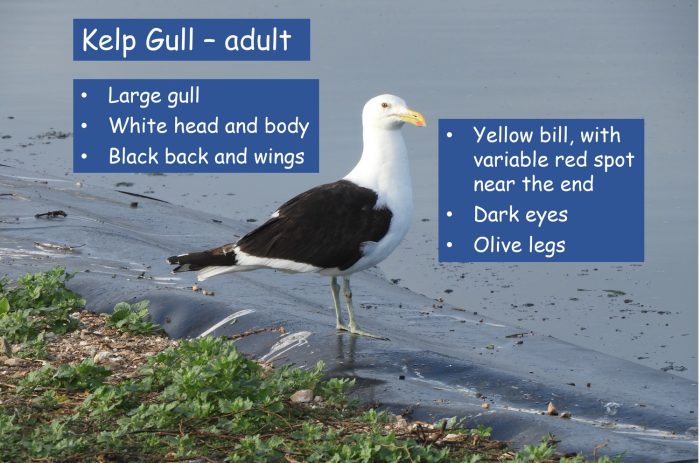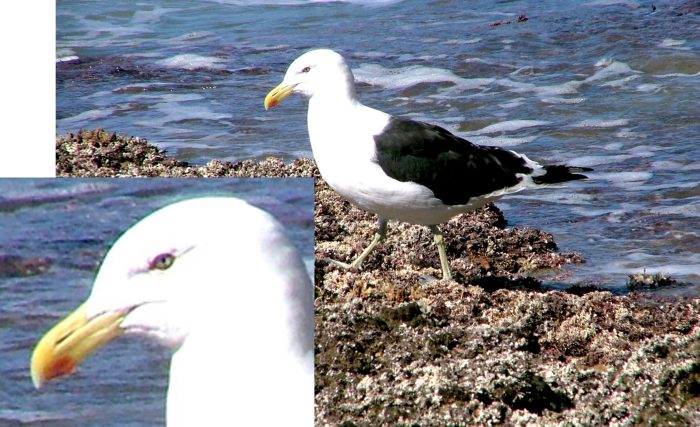Identification
Deciding that the bird you are looking at is an adult Kelp Gull is one of the easiest identification challenges: white head and body, black back and wings are the key features to look for. There are some caveats, mentioned below!

But when the bird in front of you is a a young Kelp Gull, you can be forgiven for thinking you are looking at a completely different species! The path to adult dress takes about four years. Along the route, there are various patterns of mottled brown feathers.
If you are in the interior of South Africa, and you see a large gull that looks like a Kelp Gull, it is most probably a Lesser Black-backed Gull! In the northern part of KwaZulu-Natal, especially as you get close to the border with Mozambique in summer, it is a good idea to look at the “black-backed gulls” carefully (see the distribution map below for the reason). It is worth studying the identification guide to Lesser Black-backed Gull, so you can tell the difference between this and the Kelp Gull.
The subspecies of the Kelp Gull that breeds in South Africa, Namibia and southern Angola is Larus dominicanus vetula. There are four other subspecies that breed in New Zealand, South America, southern Madagascar, the islands of the Southern Ocean, and as far south as Antarctica. These have whitish eyes as adults (like the Lesser Black-backed Gull), and occur as vagrants in southern Africa. The photo below is possibly a vagrant of the race judithae, which breeds on “nearby” the islands of the Southern Ocean, such as Marion and Prince Edward Island, Crozet Archipelago and Kerguelen Islands.

Habitat of the Kelp Gull
Kelp Gulls occur, mostly on or near the coastline, in a large variety of seawater and freshwater habitats. These photos show a small sample of the variety of habitats.
Distribution
Kelps Gull occur along the entire coastline of South Africa. Where the map below has shades of blue they are in the core of their range: the shore of the Northern Cape, Western Cape and most of the Eastern Cape. They progressively become less abundant from East London eastwards, and steadily fade out along the KwaZulu-Natal coast, and become rare along the Mozambique coastline (where, as described above, a “black-backed gull” needs to be checked carefully for being a Lesser Black-blacked Gull.
They are also often encountered at wetlands (and rubbish dumps) along the coastal plain, especially in the Western Cape and the Eastern Cape.

For example, the BirdPix section of the Virtual Museum has records at Theewaterskloof Dam, Voelvlei Dam and Clanwilliam Dam, all more than 50 km from the coastline. The rubbish tip at Malmesbury is a spot to take photographs of Kelp Gulls with unusual backgrounds:


There can be no doubt that the occurrence of Kelp Gulls far inland is attributable to human activities.
Behaviour of the Kelp Gull
Kelp Gulls are gregarious, spending most of their time in flocks, small or large. Mostly, they find their own food, either dead (i.e. they scavenge) or alive (they hunt). They are also expert kleptoparasites, stealing food from other birds …

… This Western Osprey is holding a fish that it has caught; the Kelp Gull is chasing it in the hope that the osprey will drop its catch. Kelp Gull also kleptoparasitise terns carrying fish, and other species with food, and harass birds so that they regurgitate their last meal.
Breeding
Kelp Gulls breed colonially, but isolated single nests occur occasionally.

The breeding colony on Robben Island is the largest, with several thousand nests.

This nest above is typical, a hollow lined with grass. The clutch typically has two or three eggs. Both parents incubate the eggs, they take almost four weeks to hatch.

BirdPix record 195448
The chicks are semi-precocial. That means that get up and walk away from the nest within a few hours of hatching, but that they do not feed themselves (like precocial species do). Both parents feed the chicks. The period from hatching to flying is about seven weeks.

BirdPix record 101602
Further resources: A selection of papers
- Species text in the first bird atlas (1997) Kelp Gull Larus dominicanus
- Kelp Gulls breeding in Mountain Fynbos. Fascinating article in the journal Biodiversity Observations by Peter Ryan and Bruce Dyer about a breeding colony at Steenbras Dam, 350 metres above sea level.
More common names: Kelpmeeu (Afrikaans), Goéland dominicain (French), Dominikanermöwe (German), Gaivota-dominicana (Portuguese), Kelpmeeuw (Dutch).
Photographic acknowledgements: The photographs in this identification guide are from the BDI Virtual Museum. The photographers continue to own the copyright on these images.
Recommended citation format: Underhill LG 2023. Kelp Gull Larus dominicanus. Biodiversity and Development Institute. Available online at http://thebdi.org/2023/03/12/hartlaubs-gull-chroicocephalus-hartlaubii/.










